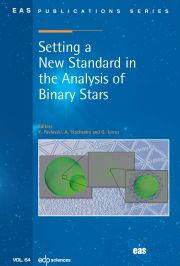No CrossRef data available.
Article contents
Cosmological Radiative Transfer andthe Line-of-Sight Proximity Effect
Published online by Cambridge University Press: 20 January 2011
Abstract
We study the proximity effect around high redshift quasars in dependence on the quasarredshift and environment using 3D continuum radiative transfer simulations. Snapshots ofdark matter only simulations at redshift 3, 4, and 4.9 are mapped to hydrogen densitiesand temperatures using an effective equation of state. The overionization zone around QSOswith luminositiesLνHI = 1031and1032 ergHz-1s-1is studied in a UV background field in radiation equilibrium. By analyzing syntheticspectra of lines of sight originating at the QSO, the proximity effect is studied. We findthat the quasar spectral energy distribution, diffusion and shadowing due to Lyman Limitsystems play a role in the signal. Density inhomogeneities around the QSO are responsiblefor a large scatter around the mean proximity effect seen in all simulated QSO spectra.This scatter is larger than the differences arising from varying quasar hostenvironments.
Information
- Type
- Research Article
- Information
- Copyright
- © EAS, EDP Sciences 2011

